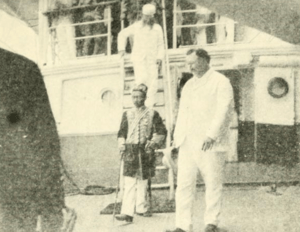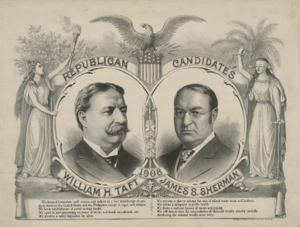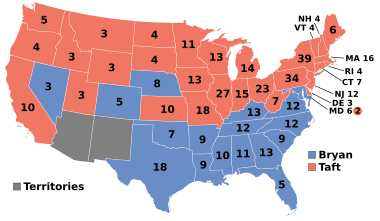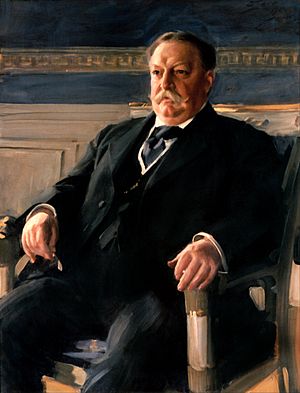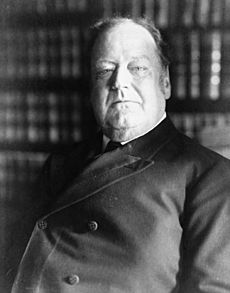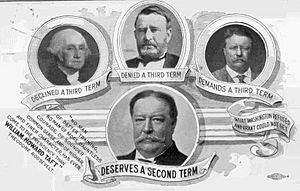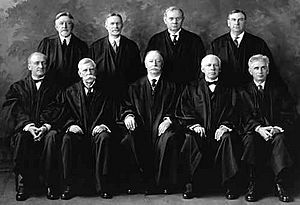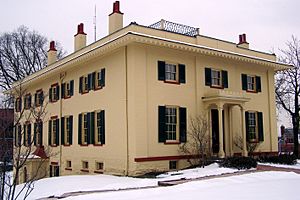William Howard Taft facts for kids
Quick facts for kids
William Howard Taft
|
|
|---|---|
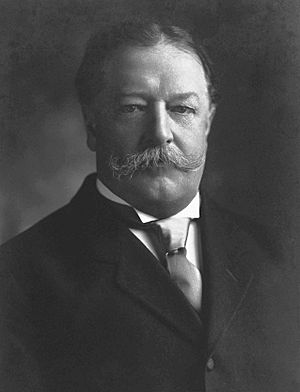
Portrait by Harris & Ewing, c. 1912
|
|
| 27th President of the United States | |
| In office March 4, 1909 – March 4, 1913 |
|
| Vice President |
|
| Preceded by | Theodore Roosevelt |
| Succeeded by | Woodrow Wilson |
| 10th Chief Justice of the United States | |
| In office July 11, 1921 – February 3, 1930 |
|
| Nominated by | Warren G. Harding |
| Preceded by | Edward Douglass White |
| Succeeded by | Charles Evans Hughes |
| 42nd United States Secretary of War | |
| In office February 1, 1904 – June 30, 1908 |
|
| President | Theodore Roosevelt |
| Preceded by | Elihu Root |
| Succeeded by | Luke Edward Wright |
| 1st Provisional Governor of Cuba | |
| In office September 29, 1906 – October 13, 1906 |
|
| Appointed by | Theodore Roosevelt |
| Preceded by | Tomás Estrada Palma (as President) |
| Succeeded by | Charles Edward Magoon |
| Governor-General of the Philippines | |
| In office July 4, 1901 – December 23, 1903 |
|
| Appointed by | William McKinley |
| Preceded by | Arthur MacArthur, Jr. (as Military Governor) |
| Succeeded by | Luke Edward Wright |
| Judge of the United States Court of Appeals for the Sixth Circuit | |
| In office March 17, 1892 – March 15, 1900 |
|
| Appointed by | Benjamin Harrison |
| Preceded by | Seat established |
| Succeeded by | Henry Franklin Severens |
| 6th Solicitor General of the United States | |
| In office February 4, 1890 – March 20, 1892 |
|
| President | Benjamin Harrison |
| Preceded by | Orlow W. Chapman |
| Succeeded by | Charles H. Aldrich |
| Personal details | |
| Born | September 15, 1857 Cincinnati, Ohio, U.S. |
| Died | March 8, 1930 (aged 72) Washington, D.C., U.S. |
| Resting place | Arlington National Cemetery |
| Political party | Republican |
| Spouse | |
| Children | |
| Parents |
|
| Relatives | Taft family |
| Education | |
| Occupation |
|
| Signature | |
William Howard Taft (September 15, 1857 – March 8, 1930) was the 27th president of the United States (1909–1913). He was also the tenth Chief Justice of the United States (1921–1930). He is the only person to have held both of these important jobs. Taft was elected president in 1908. He was chosen by Theodore Roosevelt to be his successor. However, Taft lost his reelection bid in 1912 to Woodrow Wilson. This happened after Roosevelt ran as a third-party candidate, splitting the Republican vote. In 1921, President Warren G. Harding appointed Taft as Chief Justice. He held this position until a month before he died.
Taft was born in Cincinnati, Ohio, in 1857. His father, Alphonso Taft, was a U.S. Attorney General and Secretary of War. William Taft went to Yale and became a lawyer. He quickly rose in his career, becoming a judge in his twenties. He was later named Solicitor General of the United States and a judge for the Sixth Circuit Court of Appeals. In 1901, President William McKinley made Taft the civilian Governor-General of the Philippines. In 1904, Roosevelt appointed him Secretary of War. Taft had always wanted to be Chief Justice, but he believed his political work was more important at the time.
With Roosevelt's help, Taft easily won the Republican nomination for president in 1908. He then defeated William Jennings Bryan in the election. As president, Taft focused on East Asia more than Europe. He often got involved in Latin American governments. Taft tried to lower trade tariffs (taxes on imported goods). However, the final law was heavily influenced by special interests. His time as president was marked by disagreements within the Republican Party. There were conflicts between the conservative wing, which Taft often agreed with, and the progressive wing, which Roosevelt increasingly supported. Disagreements over protecting nature and lawsuits against large companies further separated Taft and Roosevelt. Roosevelt challenged Taft for the Republican nomination in 1912. Taft used his control of the party to win the nomination. Roosevelt then left the party. This split meant Taft had little chance of winning reelection. He only won two states in Wilson's victory.
After leaving office, Taft became a professor at Yale. He stayed active in politics and worked for peace through the League to Enforce Peace. In 1921, President Harding appointed Taft as Chief Justice. This was a job he had wanted for a long time. As Chief Justice, Taft was careful about business issues. However, there were also improvements in individual rights during his time. He resigned in February 1930 due to poor health and died the next month. He was buried at Arlington National Cemetery. He was the first president and first Supreme Court justice buried there. Historians usually rank Taft in the middle among U.S. presidents.
Contents
Early Life and Education
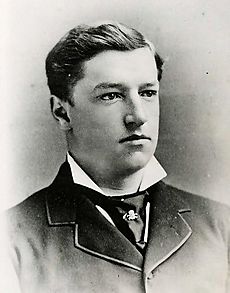
William Howard Taft was born on September 15, 1857, in Cincinnati, Ohio. His parents were Alphonso Taft and Louise Torrey. The Taft family lived in a simple home. Alphonso Taft was a judge and an ambassador. He also served as Secretary of War and Attorney General for President Ulysses S. Grant.
William Taft was not seen as a super smart child, but he worked very hard. His parents pushed him and his four brothers to succeed. He went to Woodward High School in Cincinnati. In 1874, he started at Yale College. Taft was popular and a wrestling champion there. A classmate said he succeeded by hard work, not just by being the smartest. He was known for his honesty. He joined Skull and Bones, a secret Yale society his father helped start. In 1878, Taft graduated second in his class. He then went to Cincinnati Law School and became a lawyer in 1880. While in law school, he worked for a newspaper and learned a lot about the law.
Rising in Government (1880–1908)
Early Career in Ohio
After becoming a lawyer, Taft worked as an assistant prosecutor in Hamilton County, Ohio. He handled many regular cases. In 1882, President Chester A. Arthur appointed him as a tax collector. Taft did not like firing good workers for political reasons, so he resigned in 1883 to start his own law practice.
In 1887, when he was 29, Taft was appointed to the Superior Court of Cincinnati. He was elected to a full five-year term in 1888. As a judge, he made some important decisions. For example, in one case, he ruled that a union's action was an illegal "secondary boycott." This decision was later used against him when he ran for president.
Taft met Helen Herron, often called Nellie, by 1880. They started meeting regularly by 1884. In 1885, she agreed to marry him. They got married on June 19, 1886. William Taft was very devoted to Nellie throughout their almost 44 years of marriage. Nellie Taft encouraged her husband, much like his parents did. She was also very honest with her opinions. They had three children. Their oldest son, Robert, later became a U.S. senator.
Solicitor General and Federal Judge
In 1890, President Harrison appointed Taft as Solicitor General of the United States. This job involves representing the U.S. government in cases before the Supreme Court of the United States. Taft worked hard to catch up on the work and learn federal law. He was very successful, winning 15 of the 18 cases he argued.
In 1891, Taft started a new policy. The government would admit when it thought it had won a case unfairly in a lower court. This policy continues today. In 1892, Taft became a judge on the United States Court of Appeals for the Sixth Circuit in Cincinnati. This was a lifetime job, and he enjoyed his time as a judge.
As a federal judge, Taft supported the right of workers to form unions and go on strike. He also ruled against employers in some cases where workers were injured. One of his important decisions was in Addyston Pipe & Steel Co. v. United States. He ruled that a group of pipe makers had broken the Sherman Antitrust Act. This decision helped bring that law back into use.
Governing the Philippines
In 1900, President McKinley asked Taft to lead a group organizing a civilian government in the Philippines. Taft had to leave his judge job for this. McKinley promised him a spot on the Supreme Court later. Taft agreed, becoming the civilian governor in 1901.
The Philippines was fighting for independence from the U.S. Taft wanted Filipinos to be partners in their government. He believed independence would come much later. He treated Filipinos as equals and did not allow racial segregation at official events.
After McKinley was assassinated in 1901, Theodore Roosevelt became president. Taft and Roosevelt were friends. Taft went to Rome to talk with Pope Leo XIII. He wanted to buy land from Catholic religious groups in the Philippines. He also wanted to arrange for Spanish priests to leave and be replaced by American or local clergy. An agreement was reached in 1903.
In 1902, Roosevelt offered Taft a Supreme Court job. Taft turned it down because he felt his work in the Philippines was not finished. The next year, Roosevelt asked Taft to become Secretary of War. This department oversaw the Philippines, so Taft could still be responsible for the islands. Taft agreed and returned to the U.S. in December 1903.
Secretary of War
Taft became Secretary of War in January 1904. Roosevelt mostly used Taft as a problem-solver and legal advisor. Taft also gave speeches to support Roosevelt's reelection campaign. He once wrote that being president seemed "awful."
Between 1905 and 1907, Taft realized he would likely be the next Republican candidate for president. Roosevelt offered him a Supreme Court seat twice, but Taft refused. He still wanted to be Chief Justice, but he believed the current Chief Justice, Melville Fuller, would live for many more years.
Taft was also involved in the building of the Panama Canal. He visited Panama in 1904. When the chief engineer resigned in 1907, Taft suggested an army engineer, George W. Goethals. Under Goethals, the canal project went smoothly.
In 1906, Taft became the Provisional Governor of Cuba for two weeks. This happened after Cuba's president asked for U.S. help due to political problems. Taft worked to show Cubans that the U.S. wanted stability, not to take over.
Taft continued to be involved in Philippine affairs. He pushed for Philippine farm products to enter the U.S. without taxes. He also visited Japan twice as Secretary of War. In 1905, he signed a memo with the Japanese Prime Minister. It said Japan would not invade the Philippines, and the U.S. did not object to Japan controlling Korea. In 1907, Japan informally agreed to limit the number of Japanese workers coming to the U.S. West Coast.
Presidential Election of 1908
Getting the Nomination
Roosevelt had served almost a full term after McKinley's death. In 1904, he said he would not run for reelection in 1908. He later regretted this but felt he had to keep his word. Roosevelt believed Taft was the best person to follow him. He used his power within the Republican Party to help Taft.
Many other Republican politicians thought about running but decided against it. New York Governor Charles Evans Hughes did run. However, Roosevelt often made big announcements on the same day Hughes gave important speeches. This meant Hughes's news was pushed to the back pages of newspapers. Roosevelt also stopped attempts to get him to run for another term.
Taft's campaign was led by Frank H. Hitchcock. Taft went on a speaking tour in April 1908. At the 1908 Republican National Convention in Chicago in June, Taft faced no serious challenge. He won the nomination on the first vote. Taft had hoped for a more progressive running mate, but the convention chose James S. Sherman, a conservative. Taft resigned as Secretary of War on June 30 to focus on his campaign.
General Election Campaign
Taft's opponent was William Jennings Bryan, the Democratic candidate for the third time. Bryan argued that he was the true follower of Roosevelt's reforms. He suggested that donations from company leaders to political campaigns should be banned or at least made public. Taft agreed they should be public after the election.
Taft's campaign started a bit awkwardly. He went to Roosevelt's home for advice on his acceptance speech. This made some people think he wasn't his own man. Taft supported most of Roosevelt's policies. He believed workers had the right to organize, but not to boycott. He also said that companies and wealthy people must follow the law.
Bryan wanted the government to own railroads. Taft preferred they stay private, with the government setting fair rates. Taft blamed the recent economic downturn on stock speculation. He felt changes were needed to the money system and to antitrust laws. He also thought the Constitution should be changed to allow an income tax. Taft wanted to continue Roosevelt's policies but make them stronger with new laws.
Roosevelt, who was frustrated by not being able to campaign, gave Taft lots of advice. He worried that people wouldn't appreciate Taft. Roosevelt's supporters even spread rumors that he was running Taft's campaign. This annoyed Nellie Taft.
In the end, Taft won easily. He defeated Bryan with 321 electoral votes to 162. However, he only won 51.6 percent of the popular vote. Nellie Taft said that Taft didn't know or care much about how politics was played.
Presidency (1909–1913)
Starting as President
Taft became president on March 4, 1909. A big winter storm meant he was sworn in inside the Senate Chamber, not outside the Capitol. In his speech, Taft said he was proud to have advised Roosevelt. He promised to continue Roosevelt's reforms and make them last. He also spoke about lowering tariffs and improving antitrust laws. Roosevelt left office feeling sad his time was over. He went on a year-long hunting trip to Africa to stay out of Taft's way.
Taft kept only two of Roosevelt's cabinet members. He appointed Philander Knox as the new Secretary of State. Taft did not have the same easy relationship with the press as Roosevelt. He didn't give as many interviews or photo opportunities. His presidency was quieter than Roosevelt's, focusing more on the rule of law.
First Lady's Illness
Early in Taft's term, in May 1909, his wife Nellie had a serious stroke. It left one of her arms and legs paralyzed, and she couldn't speak well. Taft spent hours each day caring for her and helping her learn to speak again. This took a year.
Foreign Policy
Dollar Diplomacy
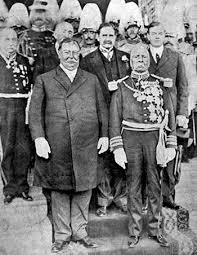
Taft and his Secretary of State, Philander Knox, created a policy called "Dollar Diplomacy" for Latin America. They believed U.S. investments would help everyone and reduce European influence. This policy was not popular in Latin American countries. They didn't want to become financially controlled by the U.S. Many in the U.S. Senate also thought the U.S. should not interfere abroad.
Mexico was facing problems under its leader, Porfirio Díaz. Many Mexicans supported his opponent, Francisco Madero. Taft tried to stop Mexican rebels from getting weapons from the U.S. He showed support for Díaz by meeting him in Mexico. This was the first time a U.S. president visited Mexico. Later, Díaz was removed from power, and a revolution began that lasted ten years. Taft avoided an aggressive response from the U.S.
Nicaragua's president wanted to cancel business deals with American companies. The U.S. supported rebel forces. Nicaragua owed money to other countries, and the U.S. didn't want Europeans to control a possible canal route there. U.S. forces interfered, and the rebels took the capital. The U.S. made Nicaragua accept a loan and sent officials to make sure it was repaid. The country remained unstable. In 1912, Taft sent troops, starting the United States occupation of Nicaragua, which lasted until 1933.
East Asia
Because of his time in the Philippines, Taft was very interested in East Asian affairs. He thought relations with Europe were less important than trade and investment in Asia. Taft and Knox tried to expand the Open Door Policy to Manchuria, but they were not successful.
An American company had a deal for a railroad in China, but the Chinese canceled it. A British group then started talks for the railroad. Knox demanded that U.S. banks be allowed to join. Taft personally asked the Chinese Prince Regent and succeeded in getting U.S. involvement. However, the Chinese government's decision to take over local railroad companies led to the Chinese Revolution of 1911.
After the revolution, the leaders chose Sun Yat-sen as provisional president of the new Republic of China. Taft was slow to recognize the new government, even though many Americans supported it. He felt recognition should be a joint action by Western powers.
Taft continued the policy against immigration from China and Japan. A new treaty with Japan in 1911 gave broad rights to Japanese people in America and Americans in Japan. This was based on the "Gentlemen's Agreement" to limit Japanese immigration.
Europe
Taft did not like the old practice of giving important ambassador jobs to rich supporters. He preferred diplomats who would represent America well. Taft supported solving international problems through arbitration. He negotiated treaties with Great Britain and France for this purpose. However, the Senate did not approve these treaties.
Even without a general arbitration treaty, Taft's administration settled several disputes with Great Britain peacefully. These included border issues, seal hunting in the Bering Sea, and fishing rights off Newfoundland.
Domestic Policies
Antitrust Actions
Taft continued and expanded Roosevelt's efforts to break up large business groups (trusts). He filed 70 antitrust lawsuits in four years, compared to Roosevelt's 40 in seven years. Lawsuits against Standard Oil Company and the American Tobacco Company, started under Roosevelt, were won by the government in 1911.
In October 1911, Taft's Justice Department sued United States Steel (U.S. Steel). The lawsuit claimed that Roosevelt had encouraged monopolies. Roosevelt was offended by these claims. Taft said he didn't know about them.
Another antitrust case that affected Taft politically was against the International Harvester Company in 1912. Roosevelt's administration had investigated this company but took no action. This lawsuit became part of Roosevelt's challenge for the Republican presidential nomination.
Ballinger–Pinchot Affair
Gifford Pinchot was a strong supporter of protecting nature, like Roosevelt. Taft agreed with conservation but thought it should be done through laws, not just presidential orders. He replaced Roosevelt's Interior Secretary with Richard A. Ballinger. Roosevelt was surprised by this change.
A government agent, Louis Glavis, investigated some coal claims in Alaska. When Secretary Ballinger approved them, Glavis went to Pinchot for help. Glavis then made his claims public, saying Ballinger had a conflict of interest. Taft fired Glavis. Pinchot then forced his own dismissal by writing a letter to a senator, criticizing Taft. Taft fired Pinchot, which pleased Pinchot. This affair made many progressives and Roosevelt supporters feel that Taft had abandoned Roosevelt's goals.
Civil Rights
Taft announced that he would not appoint African Americans to federal jobs if it would cause racial tension. This was different from Roosevelt's approach. Taft removed most black office holders in the South and made few appointments of African Americans in the North.
Taft supported the ideas of Booker T. Washington, who believed most black people should be trained for industrial work. This approach was different from W. E. B. DuBois, who pushed for full equality. Taft's policies led some African Americans to start supporting the Democratic Party.
Taft, who was a Unitarian, also helped improve how Catholicism was viewed in the early 1900s. He praised Catholic leaders and their historical role. Taft supported free immigration. He vetoed a bill that would have required a literacy test for unskilled workers, which labor unions supported.
Judicial Appointments
Taft appointed six judges to the Supreme Court of the United States. Only two other presidents have appointed more. His first appointment was Horace H. Lurton, an old friend. Lurton was 65, making him the oldest person to become an associate justice.
When Justice David Josiah Brewer died in 1910, Taft chose New York Governor Charles Evans Hughes. Taft told Hughes that he would be his choice for Chief Justice if that position became open. Chief Justice Fuller died shortly after. Taft took five months to replace Fuller, choosing Justice Edward Douglass White. White became the first associate justice to be promoted to Chief Justice. Taft also appointed Willis Van Devanter and Joseph R. Lamar to the Supreme Court.
In 1911, Justice Harlan died, giving Taft a sixth Supreme Court appointment. After Secretary Knox declined, Taft named Mahlon Pitney. Pitney was the last person appointed to the Supreme Court who did not go to law school. He was the only one of Taft's appointments to face opposition in the Senate.
Taft also appointed many judges to other federal courts. He created the United States Commerce Court in 1910 to hear appeals from the Interstate Commerce Commission. However, this court was controversial and was later abolished.
1912 Presidential Campaign
Growing Apart from Roosevelt
During Roosevelt's 15-month trip to Africa, Taft and Roosevelt did not communicate much. When Roosevelt returned, he privately expressed unhappiness with Taft's performance. However, he publicly said he expected Taft to be nominated again in 1912.
Taft and Roosevelt met twice in 1910. The meetings were polite but not as close as before. Roosevelt gave speeches criticizing the Supreme Court and calling for more progressive policies. This worried Taft, who believed Roosevelt was moving too far to the left.
In the 1910 elections, Republicans lost control of the House of Representatives. After the election, Roosevelt continued to promote his "New Nationalism" ideas. He criticized Taft's administration. The disagreement continued through 1911. Wisconsin Senator Robert M. La Follette announced he would run for president as a Republican. Roosevelt began to consider running himself, saying that the tradition of presidents not running for a third term only applied to consecutive terms.
Roosevelt received many letters urging him to run. In February 1912, he announced he would accept the Republican nomination if offered. Taft felt that if he lost the nomination, it would be a personal rejection. He was reluctant to oppose Roosevelt, who had helped him become president. But now that he was president, he was determined to stay.
Primaries and Convention
As Roosevelt became more progressive, Taft became more determined to win the nomination. He believed progressives threatened the government's foundations. One sad event for Taft was the death of Archibald Butt, a military aide who had served both presidents. Butt died on the RMS Titanic.
Roosevelt won most of the primary elections. However, Taft controlled the Republican Party's organization. This meant he gained most of the delegates chosen at state conventions. Roosevelt challenged the election of these delegates. Taft's side won most of these challenges.
Roosevelt went to Chicago for the 1912 Republican National Convention. He told his supporters, "we stand at Armageddon, and we battle for the Lord." Taft stayed in Washington. Taft's supporters won the vote for temporary chairman of the convention. This helped Taft secure the nomination. Taft was nominated on the first vote, but most of Roosevelt's delegates refused to vote.
Campaign and Defeat
Roosevelt and his followers formed the Progressive Party, claiming Taft had stolen the nomination. Taft knew he would lose the election. However, he felt he had preserved the Republican Party as "the defender of conservative government." He ran to keep conservative control of the party.
Woodrow Wilson was the Democratic nominee. Wilson focused his attacks on Roosevelt, not Taft. He argued that Roosevelt had not done enough to fight trusts. Taft compared his "progressive conservatism" to Roosevelt's Progressive democracy, which Taft saw as a "benevolent despotism."
Taft only spoke publicly once during the campaign, giving his acceptance speech on August 1. He struggled to raise money because many business leaders thought he couldn't win and supported Wilson. Taft won only two states: Utah and Vermont, for a total of eight electoral votes. Roosevelt won 88, and Wilson won 435. Wilson won with less than half of the popular vote. Taft received just under 3.5 million votes, over 600,000 less than Roosevelt.
Return to Yale (1913–1921)
After leaving the White House, Taft became a professor at Yale Law School. He taught law and legal history. He also earned money by giving speeches and writing articles. During his eight years out of office, he saved more money. While at Yale, he wrote a book called Our Chief Magistrate and His Powers (1916).

Taft was president of the Lincoln Memorial Commission. He helped decide on the materials for the memorial. He successfully pushed for the use of Colorado-Yule marble. He would later dedicate the Lincoln Memorial as Chief Justice in 1922. In 1913, Taft was elected president of the American Bar Association (ABA), a group for lawyers.
Taft had a friendly relationship with President Wilson. However, he privately criticized some of Wilson's policies. Taft was upset when Wilson nominated Louis Brandeis to the Supreme Court. Taft had never forgiven Brandeis for his role in the Ballinger–Pinchot affair. Taft and other former ABA presidents wrote a letter saying Brandeis was not fit for the Supreme Court. However, the Senate confirmed Brandeis. Taft and Roosevelt remained angry with each other. They only met once in three years, at a funeral, and spoke briefly.
As president of the League to Enforce Peace, Taft hoped to prevent wars through an international group of nations. When World War I began in Europe, Taft supported Wilson's foreign policy. He was an enthusiastic supporter when Wilson asked Congress to declare war on Germany in 1917. Taft became chairman of the American Red Cross' executive committee. He was also appointed a major general in the Red Cross.
During the war, Taft helped lead the National War Labor Board. This board worked to ensure good relations between factory owners and workers. In 1918, Taft and Roosevelt finally reconciled at a dinner in Chicago. They embraced, and Taft later wrote that he loved Roosevelt and cherished his memory.
When Wilson proposed creating a League of Nations, Taft publicly supported it. However, a small group of senators strongly opposed the League. The Senate refused to approve the peace treaty.
Chief Justice (1921–1930)
Appointment
During the 1920 election, Taft supported Warren G. Harding for president. Harding won. Taft was asked to advise Harding on appointments. Taft told Harding he would only accept a Supreme Court appointment if it was for the Chief Justice position. He said Chief Justice White had told him he was holding the position for Taft.
Chief Justice White was in poor health and died on May 19, 1921. Taft waited anxiously to see if he would be chosen. Harding also considered other people. However, Harding's Attorney General, Harry Daugherty, supported Taft. Harding named Taft as Chief Justice on June 30, 1921. The Senate quickly confirmed Taft the same day. He became the first and only person to serve as both president and Chief Justice. He was sworn in on July 11.
His Work as Chief Justice
The Supreme Court under Taft often made conservative decisions. This made it hard for the federal government to regulate businesses. The Court also struck down many state laws. Taft tried to get his fellow judges to agree and avoid disagreements. He believed the Chief Justice should be in charge of the federal courts.
Taft felt the federal courts were not well-run. Many courts had too many cases waiting, including the Supreme Court. Taft worked to get new laws passed to fix this. He wanted to add more judges and allow the Chief Justice to temporarily move judges to clear backlogs. Congress passed a bill in 1922.
Taft also wanted to change how the Supreme Court handled cases. He believed most appeals should be settled by lower courts. Only very important cases should be decided by the Supreme Court. He and other justices proposed a law to make most of the Court's cases optional. This "Judges' Bill" became law in 1925. By the next year, Taft was able to show that the backlog of cases was shrinking.
When Taft became Chief Justice, the Supreme Court did not have its own building. Its offices were crowded. Taft started a campaign to get the Court its own building in 1925. Two years later, Congress approved money to buy land for it. Taft hoped to see the Court move into the new building, but it didn't happen until 1935, after his death.
Later Years and Death
Taft is known as the heaviest president. He was 5 feet 11 inches tall and weighed up to 340 pounds during his presidency. By 1929, he weighed 244 pounds. When he became Chief Justice in 1921, his health was starting to decline. He started a fitness plan, walking three miles from his home to the Capitol each day. After his death, a bridge he often used was named the Taft Bridge.
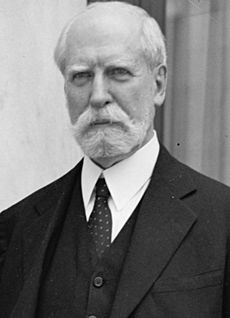
At Hoover's inauguration in March 1929, Taft made a small mistake while reciting the oath. His health slowly got worse during his time as Chief Justice. He worried that if he retired, President Herbert Hoover, whom he thought was too progressive, would choose his replacement. He wanted to stay on the court to prevent "Bolsheviki" (a term for communists) from gaining control.
Taft resigned as Chief Justice on February 3, 1930. He made sure that Charles Evans Hughes would be chosen as his replacement. Taft died at his home in Washington D.C. on March 8, 1930, at age 72. He likely died from heart disease, liver inflammation, and high blood pressure.
Taft's body lay in state at the United States Capitol rotunda. Three days after his death, on March 11, he became the first president and first Supreme Court member to be buried at Arlington National Cemetery.
Legacy
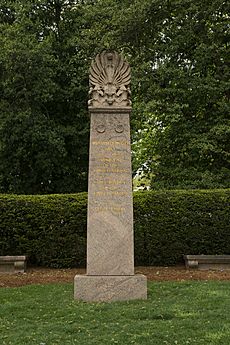
Some historians say Taft didn't get enough public credit for his policies. He quietly filed many more antitrust cases than Roosevelt. Taft was seen as "boring" but honest and likable. He is often remembered for his size and the untrue story about getting stuck in a White House bathtub. He was also the last president to have facial hair.
Historians have generally ranked Taft in the middle among U.S. presidents. This puts him in good company with presidents like James Madison and John Quincy Adams. Some argue that historians have overlooked Taft's progressive actions because he wasn't a strong public speaker or writer.
Taft is considered one of the greatest Chief Justices. He was very active in improving the Supreme Court's procedures and facilities. His biggest achievement on the Court was getting the "Judges' Bill" passed in 1925. This bill helped clear the backlog of cases. As Chief Justice, Taft was very determined in pursuing his goals for the judicial system.
The house where Taft was born in Cincinnati is now the William Howard Taft National Historic Site. His son Robert became an important political figure. He was a Senate Majority Leader and ran for president three times.
See also
 In Spanish: William Howard Taft para niños
In Spanish: William Howard Taft para niños
- Bibliography of William Howard Taft
- Taft on U.S. postage stamps


